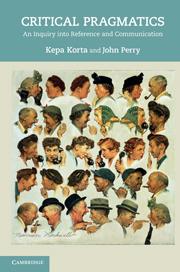Book contents
- Frontmatter
- Contents
- Preface
- Acknowledgments
- 1 Introduction
- 2 A short history of reference
- 3 Acts, roles, and singular reference
- 4 Elements of reference
- 5 Demonstratives
- 6 Context sensitivity and indexicals
- 7 Names
- 8 Definite descriptions
- 9 Implicit reference and unarticulated constituents
- 10 Locutionary content and speech acts
- 11 Reference and implicature
- 12 Semantics, pragmatics, and Critical Pragmatics
- 13 Harnessing information
- 14 Examples
- Bibliography
- Index
10 - Locutionary content and speech acts
Published online by Cambridge University Press: 05 March 2013
- Frontmatter
- Contents
- Preface
- Acknowledgments
- 1 Introduction
- 2 A short history of reference
- 3 Acts, roles, and singular reference
- 4 Elements of reference
- 5 Demonstratives
- 6 Context sensitivity and indexicals
- 7 Names
- 8 Definite descriptions
- 9 Implicit reference and unarticulated constituents
- 10 Locutionary content and speech acts
- 11 Reference and implicature
- 12 Semantics, pragmatics, and Critical Pragmatics
- 13 Harnessing information
- 14 Examples
- Bibliography
- Index
Summary
Introduction
Given our concept of reference, we can explain what we shall call, following Austin, the locutionary act. The locutionary act involves referring to an object (or objects) and predicating something of it (or them). The locutionary content, our explication of ‘what is said,’ is the referential content of the locutionary act. For the purposes of the locutionary act, the referent is the object that occupies the epistemic–pragmatic role the speaker intends to exploit, whether or not it is the object to which he intends to refer. Similarly, the locutionary content may not be what the speaker intended to say, as in various of the examples we have discussed. The untoward consequences of inept pointing, the usual basis of what we called the forensic element of saying in such cases, is handled at the level of perlocutionary acts, and the issue of responsibility will be seen not as a case of responsibility for what was said, but responsibility for the unintended but in these cases foreseeable consequences of carelessness.
Our plan for this chapter is as follows. In §10.2 we give an overview of our reasons for distinguishing locutionary content from what is said. In §10.3 we explain locutionary content in the context of speakers' plans. In §10.4 we look at a number of examples to show how locutionary content can diverge from what is said. In §10.5 we compare our concepts to Austin's, and consider Searle's misgivings about locutionary acts.
- Type
- Chapter
- Information
- Critical PragmaticsAn Inquiry into Reference and Communication, pp. 114 - 124Publisher: Cambridge University PressPrint publication year: 2011



